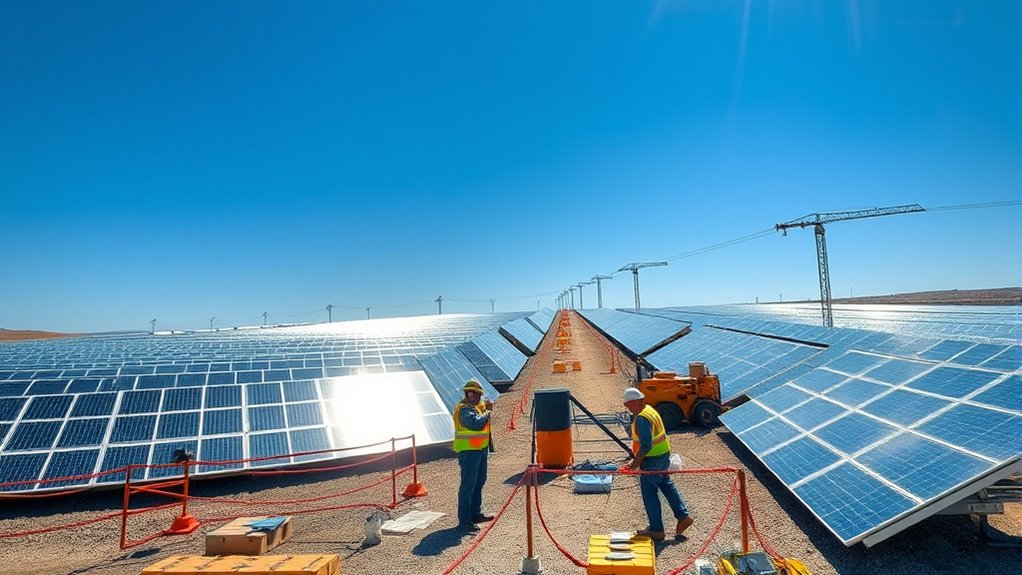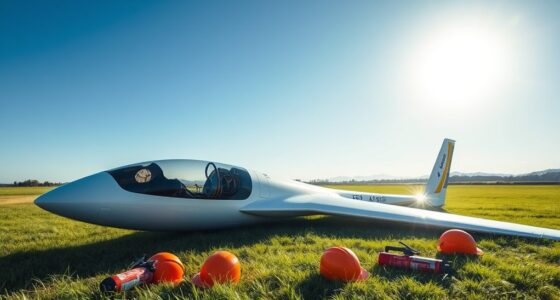When planning a solar farm construction site, you need to identify hazards like wildlife disruption, habitat sensitivities, traffic risks, and terrain instability. Assess local ecosystems and set buffer zones to safeguard wildlife. Develop a traffic management plan with clear routes and scheduling. Guarantee site access is safe and emergency routes are planned. Conduct soil and terrain assessments to prevent accidents. By recognizing these hazards early, you can develop strategies to keep your project safe and compliant.
Key Takeaways
- Conduct comprehensive site assessments to identify wildlife, habitat sensitivities, and terrain stability before construction begins.
- Develop traffic management plans that include designated routes, signage, and scheduling to minimize road disruption and accidents.
- Mark clear emergency routes and ensure accessible pathways to facilitate quick response and hazard mitigation.
- Implement buffer zones and timing strategies to avoid disturbance during breeding or migration periods of local wildlife.
- Regularly evaluate soil stability and environmental conditions to recognize hazards early and adapt construction plans accordingly.

Planning a solar farm construction site requires careful attention to safety from the very beginning. You need to be proactive in identifying potential hazards that could compromise worker safety or disrupt nearby communities. One of the first aspects to consider is wildlife disruption. Solar farms are often built in rural or undeveloped areas, which may be home to various species. Your planning must include measures to minimize disturbance to local wildlife, such as scheduling construction activities outside of critical breeding or migration periods and creating buffer zones. Not only does this protect local ecosystems, but it also helps prevent conflicts with environmental regulations that could delay your project. By evaluating the habitat and understanding the species present, you can implement strategies like fencing or noise control to reduce the impact. Ignoring wildlife considerations can lead to legal issues, project delays, and damage to your reputation. Additionally, understanding the habitat and its characteristics enables better planning to avoid sensitive areas and ensure compliance with environmental standards.
Another essential safety concern is traffic management. During construction, heavy machinery, delivery trucks, and worker vehicles will increase road activity around your site. Poor traffic management can lead to accidents, injuries, or disruptions to local traffic flow. You should develop an all-encompassing traffic plan that designates specific routes for construction vehicles, controls access points, and schedules deliveries during off-peak hours whenever possible. Clear signage, barriers, and flaggers help guide vehicles safely, reducing the risk of collisions with workers or pedestrians. Communicating these plans to local authorities and communities is key to avoid misunderstandings or complaints. Proper traffic management not only safeguards everyone on-site but also maintains good relations with neighbors and authorities.
Beyond wildlife disruption and traffic management, you must also think about site access, emergency routes, and the stability of the terrain. Ensuring that pathways are clear and well-marked prevents trips and falls. Conducting soil evaluations helps you identify areas prone to erosion or instability, reducing the chance of accidents during construction. Additionally, you should plan for emergency procedures, including accessible exit routes and readily available safety equipment. Recognizing hazards early and designing your site with safety in mind helps prevent accidents, keeps construction on schedule, and ensures compliance with safety regulations.
Frequently Asked Questions
How Are Emergency Procedures Coordinated on Solar Farm Sites?
You coordinate emergency procedures on solar farm sites by conducting regular emergency drills to make certain everyone knows their roles. You also guarantee medical preparedness by having first aid kits and trained personnel available. Clear communication channels are established so workers can quickly report incidents. You review and update procedures routinely, making sure all team members are familiar with evacuation plans and emergency contacts for swift, effective responses during any incident.
What Training Is Required for Construction Workers?
Think of training as your shield on site. You’ll need thorough instruction on hazard communication to spot risks early and properly interpret safety signs. Construction workers must also be trained in the correct use of personal protective equipment (PPE) to guard against hazards like electrical shocks or falls. Regular safety briefings, equipment handling, and emergency procedures ensure you’re prepared, confident, and safe while building the solar farm.
How Is Weather Risk Managed During Construction?
You manage weather risks during construction by monitoring forecasts and adjusting schedules accordingly. To mitigate environmental impact, you plan for adverse conditions that could cause erosion or damage. Regular equipment maintenance guarantees safe operation in bad weather, preventing breakdowns and accidents. By staying proactive, you protect workers, minimize environmental harm, and keep the project on track, even when weather becomes unpredictable.
What Signage and Barriers Are Essential for Safety?
You’ll want warning signs that shout “Caution!” to catch everyone’s eye, guiding workers safely through the maze. Physical barriers act as sturdy walls, preventing accidental entry into danger zones. Together, warning signs and barriers form an unbreakable shield, turning chaos into clarity. Make sure signs are clear and barriers are robust, so safety isn’t just a word but a visible, unwavering presence on your solar farm construction site.
How Is Site Security Maintained to Prevent Unauthorized Access?
You maintain site security by installing sturdy perimeter fencing that clearly defines the construction boundaries. You control access with secure entry points, such as gates with lock systems or card access, to prevent unauthorized personnel from entering. Regularly monitor these points, guarantee all visitors sign in, and restrict access to only authorized workers. By enforcing strict access control and maintaining robust fencing, you effectively prevent unauthorized access and protect the site.
Conclusion
By recognizing hazards, evaluating risks, and implementing controls, you guarantee safety at every stage. By planning thoroughly, communicating clearly, and training consistently, you create a secure environment. By prioritizing safety protocols, respecting site conditions, and fostering teamwork, you protect yourself and others. Remember, safe planning is proactive planning, focused on prevention and prepared for challenges. Embrace safety as your foundation, your responsibility, and your commitment—because a secure site is a successful site.
With a heart that soars as high as the skies, Aria, affectionately known as “Skylark,” is the driving force behind Soaring Skyways. Her journey into the gliding world began as a young dreamer gazing up at the soaring birds, yearning to experience the weightlessness and freedom they embodied. With years of experience both in the cockpit and behind the scenes, Aria’s commitment to the gliding community is unwavering.










